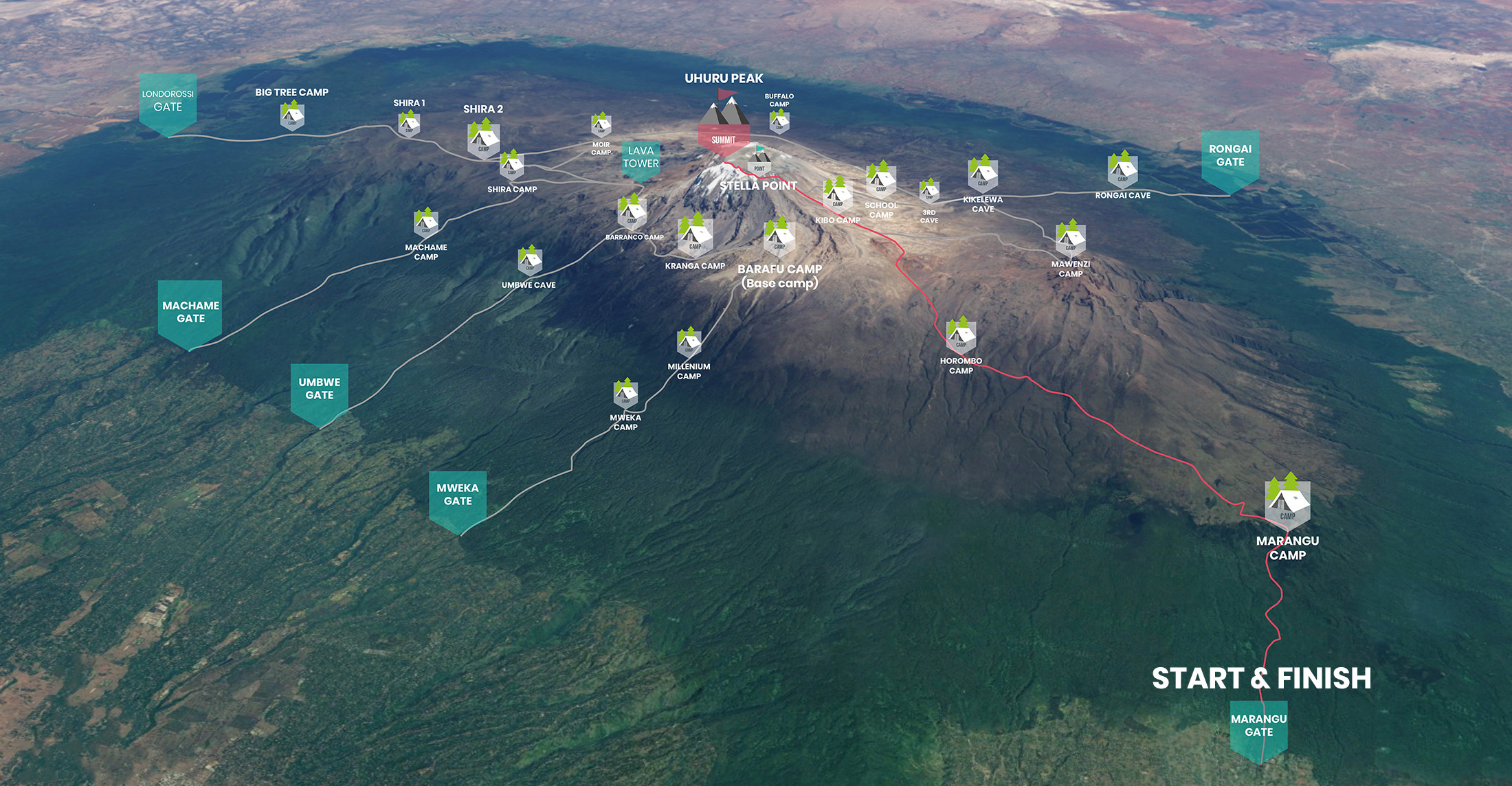Mt Kilimanjaro
The Roof Of AfricaMount Kilimanjaro
Tanzania is home to the highest mountain in Africa – Mount Kilimanjaro (5895 metres), which is also the highest free-standing mountain in the world. Despite its height Kilimanjaro is one of the world’s most accessible high summits, with most climbers reaching the peak (Uhuru Peak) with little more than a walking stick, proper clothing and determination

The ascent of Kilimanjaro can be done from six routes: Mweka, Umbwe, Shira, Rongai, Machame, and the Marangu Route which is the easier one. Depending on which route one wants to take, the climb of Kilimanjaro can take between four to six nights on the mountain. The two most popular routes are Marangu and Machame. On the Marangu Route, accommodation is in alpine huts while on Machame Route it is camping throughout. While expert guides and porters will accompany you on your climb, no technical equipment is required on these routes.
MT KILIMANJARO – ROUTES DESCRIPTION
MARANGU ROUTE
The Marangu or main route is by far the most popular way to the summit. The ascent is more gradual and no professional equipment is required. The accommodation on the way up and down is provided in mountain huts with all the basic necessities. There are 60 bunk beds each (for 60 people each) at Mandara Hut (2700m) and Kibo Hut (4700m), and 120 bunk beds (for 120 people) at Horombo Hut (3720m) which is also used for descent. Climbers are supplied with mattresses and pillows, but sleeping bags should be brought along. There are communal dining halls, washrooms and toilets.
It usually takes 5 days/4nights for the round trip. The trek can also be taken in 6 days/5 nights to add acclimatization with an extra day at Horombo Hut. The supplementary cost for an extra day is indicated separately as an option.
MACHAME ROUTE
This is probably the most scenic route up Kilimanjaro. The accommodation on the way up and down is strictly camping (mobile tents) only. This trek is strenuous and may be better suited to more adventurous hikers. The Machame route is normally completed in a minimum of 6 days/5nights on the mountain.
LEMOSHO(SHIRA) GLADES ROUTE
The Lemosho Glades route is perhaps the least used initial ascent route on Kilimanjaro, partly because of its remote location and likewise the difficult roads leading to the trailhead. The road to the trailhead is only accessible by 4-wheel drive vehicles and can be impassable during wet periods. The trailhead is at relatively high elevation, and thus we start slow and easy on this route. Buffalo and elephant sightings are possible on the first day trekking through the forest, and the trail is often overgrown from lack of use.
The route is the longest distance to trek up Kilimanjaro, so fitness certainly plays a role in the enjoyment and success of this trek. The Lemosho (Shira) route takes 7 days / 6 nights on the mountain. Overall, the distance covered and the intensity of the final few days make this trek a good choice only for the experienced hiker. The many changes of scenery and spectacular hike across the Shira Plateau make this trek truly special. There are no huts on this route, the accommodation is in mountain tents.
UMBWE ROUTE
The Umbwe route, which is based in the south, is a 6-day / 5-night tour and is said to be the most scenic and difficult one offered on Kilimanjaro. The first two days are extremely steep, muddy and generally strenuous making it only suitable for well-trained mountaineers. An acclimatization day is rarely offered on the standard programme, but can be added whereby giving the climber an extra day in the Karanga Valley. The descent trail is the same as the Mweka Route.
RONGAI ROUTE
There is only one route over on the north eastern side of the mountain, Rongai, which is usually a five night climb. This lesser known track may not be quite as spectacular as the western routes, but it does usually have far lower traffic than the other five night routes. This route retains a sense of unspoilt wilderness and offers a different perspective on Kilimanjaro by approaching it from the north.It is generally considered to be the easiest of the quality routes on the mountain. Rongai is the best route for people who are looking for a decent quality experience and are perhaps not absolutely confident about their fitness.
WHEN TO CLIMB KILIMANJARO
While weather in Tanzania changes seasonally, Kilimanjaro is so massive, it essentially creates its own weather patterns.
That means you can expect fairly consistent weather on Kilimanjaro year-round. No matter when you trek, plan around the following weather conditions:
- It will be tropical in the foothills, with high humidity and temperatures in the high 70s-90s.
- Conditions at the summit are arctic; nighttime temperatures often drop below zero.
- Along the way, you will experience every temperature in between.
- No matter when you climb you could encounter heavy rainfall or snow.
- You should not climb in April, early May, or late November; weather on and off the mountain is too wet for comfortable treks.
- The rest of Tanzania experiences cooler, drier weather in the dry season (late May through October); and warmer, wetter weather in the green season (December through March).
If you’re planning to add a safari, keep in mind the following:
- Dry season safaris often feature high concentrations of animals around scarce water sources
- Green season is when most animals give birth; thousands of baby animals can be seen during these months.
- Green season features lush vegetation throughout the country.
- During the dry season destinations are often more crowded, as it’s a popular time to travel.
- No matter when you travel, you’ll see thousands of animals.
- Temperatures year-round are warm and temperate.


















